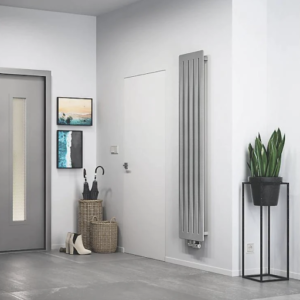A design tip that can really elevate your home is investing in a statement or designer radiator. Designer terma radiators allow you to organically fit large, non-standard heating elements into the interior. Popular batteries are installed in private and apartment buildings, offices, and studies. In order for the product to work effectively, it is important to select it exactly according to the parameters of the room. In this post, we explore different option you may consider.
Vertical radiators
As a rule, designer radiators are distinguished by their impressive height – it is several times greater than the width. Elongated narrow batteries are installed near panoramic windows, doorways, and in niches. Such equipment is often found in bathrooms.
Advantages of designer models:
- The air is heated evenly throughout the entire height of the room;
- Vertical free space is effectively used;
- A barrier is created to prevent noticeable flows of cold air from entering.
The vertical type battery looks compact and aesthetically pleasing. Some models that match the color of the walls can be made almost invisible.
The appearance of heating devices is determined by the type of construction. It is possible to install batteries from traditional pipe sections or with innovative ceramic panels. The first design option resembles a classic radiator. Can be painted with matte or glossy paint. The second option is a smooth heating surface that is not far behind the wall.
When choosing a designer radiator, consider:
- Available connection type. Water batteries require a hot water supply. Electric ones only need an outlet. Combined models require water and electricity supply. It is also necessary to determine how the product will be connected – bottom, side or diagonal.
- Coolant quality. Low quality water will quickly ruin the inside of the device. If the level of coolant contamination is high, either filters are installed or an electric radiator is purchased.
- Available space. There are standards for removing heating devices from walls, floors, water sources, electrical appliances, and other objects. Installation of the device will require more space than its actual dimensions.
- Operating pressure of the device. The coolant pressure of the central heating system of an apartment building is usually 4.-4.5 bar. A separate heating system of an apartment or house is usually within the range of 2.-2.5 bar. However, it is necessary to check each system before choosing a radiator. Heating systems of apartment buildings are susceptible to water hammer. Some cottage owners can maintain coolant pressure up to 7-10 bar. Exceeding the operating pressure will lead to damage to the device, cracks, and leaks.
- Heat transfer level. The parameter shows how quickly the room will heat up. Choosing a battery with low heat output will result in excessive energy consumption for heating. Installing a device that is too powerful will cause sudden temperature changes.
Today they offer many options for vertical designer batteries. You can choose a suitable option for any interior.
You may also be interested in these similar posts:
How to choose a towel radiator for your home

